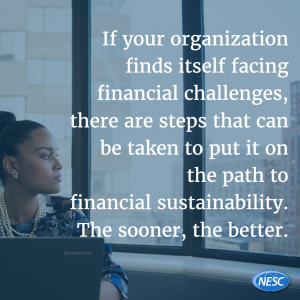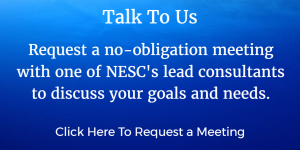
This is the time of the year when many nonprofit organizations are focused on preparing their budgets for the new fiscal year that will begin in July. As you complete your budget checklist, it’s important to look beyond just the next year’s finances, and think about the long-term sustainability of your organization.
The financial sustainability of a nonprofit organization must be a priority of its leadership team and board. It should also be incorporated into both its ongoing management decisions as well as its longer-term strategic planning. Yet, nonprofits often only focus on financial sustainability reactively – usually after a decline in revenue reveals an unsustainable business model.
Organizations that rely on grants or on a small number of major donors can be particularly vulnerable because of the inherent unpredictability and variability of such revenue sources.
Financial Reasons for Unsustainability
On a surface level, there are four primary financial reasons why nonprofits find themselves in an unsustainable situation:
- An excessive cost structure that can’t be supported by the ongoing revenue the organization receives
- The deferral of discretionary or non-urgent expenses such as maintenance, which may make the P&L look better in the short run but which will lead to higher costs in the future
- The failure to budget or plan for major cost increases (such as a lease renewal) or one-time expenses (such as recruiting fees or a major capital purchase)
- An unpredictable change in revenue, e.g., loss of grant funding or a major donor
But in our work with hundreds of nonprofit organizations over the years, we’ve found that there are usually more fundamental underlying reasons why nonprofits find themselves in financial straits. These reasons are often tied to organizational culture and management practices:
5 Real Reasons Why Nonprofits Fail Financially
- Smaller nonprofits in particular may have leadership with limited financial experience, who have either limited interest in – or knowledge about – financial management. This can be especially true when the founder still runs the organization. If an organization’s board and staff are narrowly focused on mission but not on financial operations, or if they have limited experience in financial management but don’t have a diverse team around them to draw on a broader range of experience, then they can be caught off guard when unexpected financial gaps develop.
- Board members are disengaged. Ultimately, the board has fiduciary responsibility for overseeing the organization and asking the tough questions that need to be answered in order to ensure financial sustainability. If the board is disengaged, or if it doesn’t have the skills/tools to monitor an organization’s financials, it increases the likelihood of financial surprises that may be difficult to overcome by the time they become apparent.
- The organization fails to do long-term planning. Lack of long-term planning can lead to overspending before sustainable revenue streams can be developed to support the cost structure. Without a contingency plan to deal with revenue reductions, an unexpected reduction in grant funding or other loss of revenue can be fatal for an organization.
- There is a lack of diversification in revenue streams. Overreliance on government grants, which can be unreliable or variable – or on individual major donors, who can die or move away or shift focus – can make it difficult for the nonprofit to adjust if that funding is cut and there are no alternative sources of significant income to draw on.
- The organization is slow to respond to market changes that affect its financial strength. Any nonprofit organization can face this issue. However, a nonprofit with an entrenched organizational culture and leadership team can find it especially challenging to make the changes in service offerings and operations that are necessary to ensure financial sustainability.
How To Overcome (And Avoid) Financial Challenges
If your organization is facing unexpected financial challenges, the most immediate need is to bring the cost structure in line with the revenue:
- Align critical resources. Review all of your expenses, and cut those that are not critical to delivering on your mission.
- Look for opportunities to reduce costs through outsourcing or shared services. Functions with high fixed costs, such as operations and technology, can often be handled more efficiently by a third-party partner.
- If possible, bring in volunteers to address short-term issues. Determine whether any longer-term functions could be handled by volunteers.
- Consider a partnership or merger with a complementary organization, in which combined overhead costs can be reduced.
Long-term sustainability will depend on growing revenue, addressing the organization’s culture and leadership issues as well. Here are some tips for long-term sustainability:
- Make long-term planning for revenue development a priority. Successful fundraising events can take a year or more to plan, and alternate revenue sources such as social enterprise can take even longer to develop. Your planning should also include contingency plans to address any future revenue shortfalls.
- Establish key performance indicators and review them at least once a month. Also, the board should have a Finance Committee that receives these reports and monitors the financial health of the organization.
- Recruit leadership that has multi-disciplinary experience. Smaller nonprofits can rarely afford senior-level specialists for each separate function, so ideally the executive director and management team should be able to deal comfortably with all key functions – especially program delivery, marketing, finance, and technology. At the very least, the executive director should have a team whose skillsets complement his/her strengths and compensate for any gaps.
- Board members should be counted on to provide essential expertise or financial support, either individually or through their connections, to the organization. Any board members who are not providing value to the organization should be replaced.
The best way to ensure your nonprofit’s financial sustainability is to have a solid plan in place, backed by a board in addition to fully engaged leadership with the necessary complement of skills. But if your organization finds itself facing financial challenges, there are steps that can be taken to put it on the path to financial sustainability. The sooner, the better.
Agree? Disagree? Share your thoughts in the Comments below.

